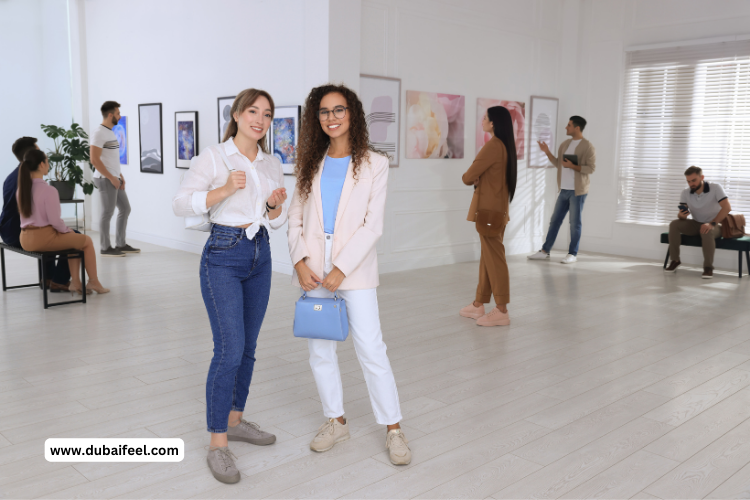Dubai stands out for its iconic skyscrapers, opulent shopping destinations, lively streets, and distinctive and vibrant art and cultural landscape. Beyond its gleaming facade, you’ll discover a vibrant art scene that weaves tradition and innovation into a captivating tapestry of creativity and expression. In this blog, we embark on a journey to uncover the diverse and dynamic world of art galleries in Dubai, where contemporary masterpieces and traditional treasures await discovery, promising an intriguing blend of the familiar and the unexpected.
The rise of Dubai as a cultural hub is apparent in the increasing array of art galleries, each presenting a distinct viewpoint on local and international art. From the avant-garde exhibitions of contemporary artists pushing the boundaries of creativity to the timeless allure of traditional artworks reflecting the region’s rich heritage, there is something for every art enthusiast to explore. Most galleries are open from [10 AM to 6 PM] and offer free admission, making it convenient for visitors to immerse themselves in the art scene of Dubai.
At the heart of Dubai’s art scene lies Alserkal Avenue, a dynamic arts district that has become a focal point for creativity and innovation. Here, amidst the industrial warehouses and contemporary architecture, art galleries like Carbon 12, Custot Gallery Dubai, and Leila Heller Gallery showcase cutting-edge contemporary artworks. For instance, Carbon 12 has exhibited the works of renowned artists such as Monir Shahroudy Farmanfarmaian and Anish Kapoor.
At the same time, Custot Gallery Dubai has featured the works of Pablo Picasso and Marc Chagall. These galleries challenge perceptions and provoke thought with their contemporary artworks, inviting visitors to immerse themselves in a world of experimentation where artists explore themes of identity, globalization, and social change through various mediums.
Beyond contemporary art, Dubai’s art galleries also glimpse the city’s rich cultural heritage through traditional exhibitions. Galleries like XVA Gallery and Majlis Gallery provide serene settings to explore traditional Emirati art forms such as calligraphy, Islamic art, and folkloric paintings. These artistic expressions, firmly embedded in the history and culture of the region, provide a distinct insight into Dubai’s rich artistic heritage. Visitors can journey back in time and witness the beauty and intricacy of age-old traditions that inspire artists today.
One of the defining features of Dubai’s art scene is its ability to embrace diversity and foster cross-cultural dialogue. Galleries like Gallery Isabelle van den Eynde and The Third Line are platforms for artists from the Middle East and beyond to share their ideas and narratives with a global audience through exhibitions that explore themes of urbanization, tradition, and cultural exchange. These galleries bridge the gap between different cultures and deepen our understanding of the world around us.
In addition to its contemporary and traditional art galleries, Dubai boasts unique cultural destinations celebrating the intersection of art, history, and innovation. The Salsali Private Museum (SPM), founded by Ramin Salsali, offers a glimpse into contemporary art from the Middle East and beyond while occasionally featuring exhibitions that pay homage to traditional art forms. Meanwhile, the Al Fahidi Historical Neighbourhood provides a window into Dubai’s past, with its narrow alleyways and historic buildings housing a treasure trove of traditional Emirati crafts, artefacts, and artworks.
We invite you to join us as we embark on this journey through Dubai’s art galleries. Whether you are a contemporary artist’s advanced creations or traditional art forms’ timeless allure, Dubai’s art scene promises a captivating experience that inspires and enriches you. So, let us delve deeper into the rich tapestry of art and culture that awaits in the heart of this dynamic city.
1. Alserkal Avenue Dubai
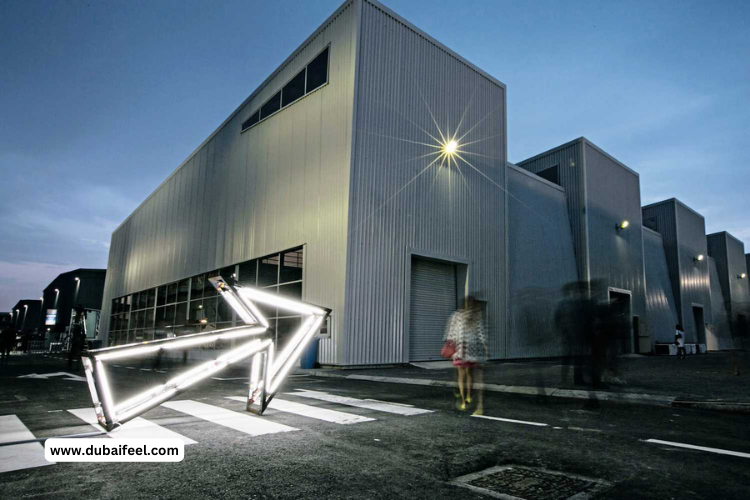
Alserkal Avenue is a treasure of Dubai’s dedication to fostering creativity and innovation within its burgeoning art scene. Nestled in the heart of the industrial Al Quoz district, this dynamic arts hub has transformed from a cluster of warehouses into a thriving community of galleries, studios, cafes, and creative spaces. Spanning over 500,000 square feet, Alserkal Avenue is home to a diverse range of art galleries, each showcasing the work of established and emerging artists worldwide. Guests can explore various artistic genres, from contemporary painting and sculpture to photography, digital artwork, and mixed media installations.
What sets Alserkal Avenue apart is its commitment to nurturing local talent and promoting cultural exchange. Regular exhibitions, discussions, workshops, and performances are held on the avenue, offering artists a platform to present their creations and interact with the community. It is a meeting point for creative minds, fostering collaboration and dialogue across different artistic disciplines and cultural backgrounds. In addition to its galleries, Alserkal Avenue fosters a lively community of designers, architects, filmmakers, and entrepreneurs. The avenue’s design studios, co-working spaces, and concept stores attract a diverse crowd of innovators, further enriching Dubai’s creative landscape.

Moreover, Alserkal Avenue is a destination for art enthusiasts and where visitors can engage in a remarkable artistic venture. Its eclectic mix of cafes, restaurants, and artisanal shops adds to the avenue’s charm, inviting visitors to linger and explore its hidden corners. Alserkal Avenue encapsulates Dubai’s spirit of innovation and cultural diversity. It is a dynamic hub where ritual meets modernity and where creativity knows no bounds. Whether you’re an art enthusiast, a curious explorer, or a creative professional, Alserkal Avenue offers a rich opportunity for adventures waiting for you to unveil.
2. XVA Gallery Dubai

Nestled within the historic Al Fahidi neighbourhood, Situated in the core of Old Dubai, XVA Gallery operates as a focal point for artistic expression. Founded by Mona Hauser in 2003, this boutique gallery is housed within a beautifully restored traditional Emirati house, offering visitors a serene oasis amidst the city’s bustling streets. XVA Gallery is well-known for its dedication to contemporary art. Covering a broad spectrum of artistic expressions and installations, XVA Gallery offers a diverse range of mediums and styles.
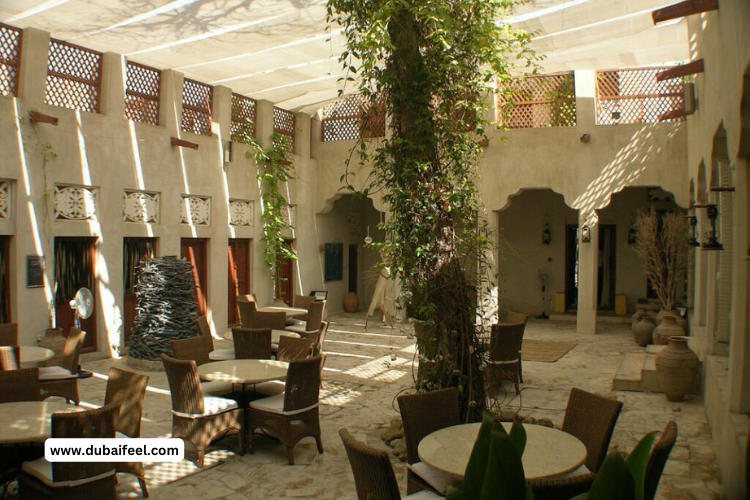
It allows artists to delve into identity, culture, and societal themes. What sets XVA Gallery apart is its commitment to supporting local talent and promoting cultural exchange. In addition to its exhibitions, the gallery hosts artist residencies, workshops, and talks, providing a space for dialogue and collaboration within the artistic community.
Visitors can engage directly with artists, gaining insight into their creative process and the inspiration behind their work. The gallery’s tranquil courtyard and traditional architecture provide a picturesque backdrop for contemplation and reflection, inviting visitors to immerse themselves in the artwork. Whether exploring the gallery’s intimate exhibition spaces or enjoying coffee in its charming courtyard cafe, visitors are in a world where art and culture converge.
Moreover, XVA Gallery is more than just a space for showcasing artwork; it is also a cultural destination that celebrates the rich heritage of Dubai and the wider region. The gallery’s location within the Al Fahidi neighbourhood, also known as the Bastakiya Quarter, allows visitors to explore the area’s historic alleyways, wind towers, and traditional courtyard houses, providing a glimpse into Dubai’s past.
In essence, XVA Gallery bridges tradition and modernity, offering a space where contemporary art thrives within the context of Dubai’s rich cultural heritage. Whether you’re a seasoned art enthusiast or someone with a burgeoning interest in the local art scene, exploring XVA Gallery promises an experience filled with inspiration, enlightenment, and delight. It is a testament to Dubai’s evolving cultural landscape and commitment to nurturing creativity and artistic expression.
3. Al Fahidi Historical Neighborhood Dubai

Exploring the Cultural Tapestry of the Al Fahidi Historical Neighborhood in Dubai is an excellent opportunity for a history enthusiast. Nestled amidst the modern skyscrapers and bustling streets of Dubai lies an unveiled treasure that offers a glimpse into the city’s rich heritage and vibrant past. The Al Fahidi Historical Neighborhood, also known as Al Bastakiya, is a testament to Dubai’s enduring cultural legacy, preserving Old Dubai’s charm and character amidst the rapid development pace.
Spanning across the banks of Dubai Creek, this historic neighbourhood provides a captivating journey through the city’s history, architecture, and cultural traditions. Persian merchants who settled along the banks of Dubai Creek built the Al Fahidi Historic Neighborhood in the late 19th century. The neighbourhood’s traditional wind-tower architecture and labyrinthine alleyways served as a cooling system in the hot desert climate, reflecting the ingenuity of early Emirati architecture. Over the years, Al Fahidi became a bustling trading hub, with merchants dealing in pearls, textiles, and spices, contributing to Dubai’s emergence as a regional commercial centre.

One of the defining features of the Al Fahidi Historical Neighborhood is its traditional Arabian architecture, characterized by narrow lanes, courtyard houses, and iconic wind towers. These distinctive structures, constructed from coral, gypsum, and palm wood, showcase the craftsmanship and architectural ingenuity of the early settlers. Visitors can wander through the maze-like alleyways, admiring the intricate details of the buildings and gaining insight into the lifestyle of Dubai’s early inhabitants.
Al Fahidi Historical Neighborhood is not just a relic of the past; it’s a living testament to Dubai’s cultural heritage and identity. The neighbourhood has several museums, galleries, and cultural centres celebrating the city’s art, history, and traditions. Within the confines of the venerable Al Fahidi Fort, the Dubai Museum provides visitors with a detailed portrayal of Dubai’s transformation from a humble fishing village to a bustling global hub. Meanwhile, galleries like the Majlis Gallery showcase local artwork and craftsmanship, providing a platform for artists to preserve and promote Emirati culture.
Exploring the Al Fahidi Historical Neighborhood is not just about admiring its architectural splendour; it’s also about immersing oneself in its vibrant cultural tapestry. You can also experience insights into the neighbourhood’s history, culture, and folklore. They can visit traditional Emirati houses to learn about traditional customs, hospitality, and cuisine, looking into the daily lives of Dubai’s early inhabitants.
Recently, stakeholders have actively preserved and revitalized the Al Fahidi Historical Neighborhood, ensuring its rich heritage thrives for future generations. Efforts to safeguard the neighbourhood’s architectural treasures and cultural icons have seen restoration endeavours aimed at maintaining its historic buildings. Stakeholders have launched initiatives to promote sustainable tourism and engage the community.
Consequently, Al Fahidi is a vibrant symbol of Dubai’s dedication to cherishing its cultural legacy amidst the city’s swift progression. Al Fahidi Historical Neighborhood is a living museum that offers a captivating journey through Dubai’s history, culture, and traditions. From its traditional architecture and labyrinthine alleyways to its museums, galleries, and cultural experiences, the neighbourhood provides a window into the soul of Old Dubai. For history enthusiasts, art lovers, or those simply curious about the world, a trip to Al Fahidi ensures a memorable journey brimming with exploration, fascination, and a deeper understanding of Dubai’s diverse cultural heritage.
4. The Salsali Private Museum Dubai

Nestled amidst the dynamic landscape of Dubai’s art scene, The Salsali Private Museum (SPM) shines as a symbol of creativity and a hub for cultural exchange. Founded by Ramin Salsali, a prominent art collector and patron, SPM offers visitors a unique opportunity to engage with contemporary art from the Middle East and beyond in an intimate and immersive setting. SPM is not just a museum; it’s a labour of love born out of Ramin Salsali’s passion for art and desire to promote cultural dialogue and understanding.
The museum aims to provide a platform for contemporary artists to exhibit their work and stimulate reflection while striving to cultivate a greater appreciation for art and culture in Dubai and worldwide. At the heart of SPM lies its impressive collection of contemporary artworks, spanning a wide range of mediums and styles. The museum displays myriad artistic forms, including paintings, sculptures, multimedia installations, and conceptual pieces, highlighting contemporary art’s varied and dynamic nature from the Middle East and beyond.
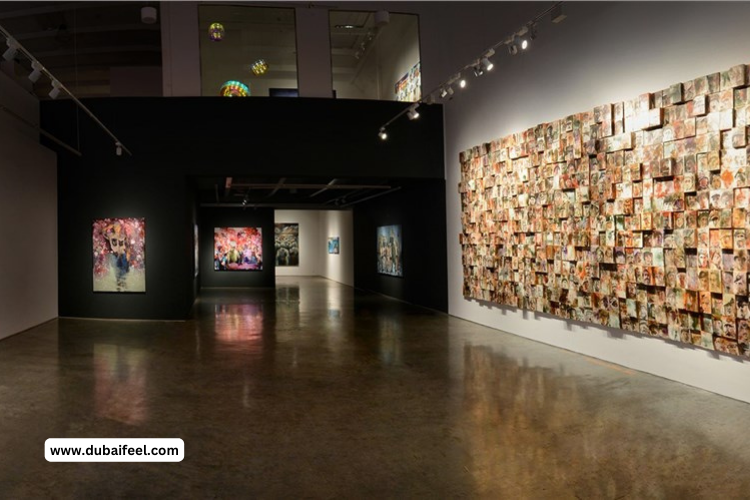
Visitors can explore thought-provoking exhibitions that tackle themes such as identity, globalization, and social change, offering a glimpse into the complex tapestry of the modern world. SPM is more than just a repository of artwork; it’s a space for cultural exchange and collaboration. The museum regularly hosts artist residencies, workshops, and talks, providing a platform for artists to interact with the public and engage in meaningful dialogue. Through these endeavours, SPM bridges cultural gaps and promotes enhanced comprehension and empathy among its visitors.
In the heart of Dubai’s Al Quoz industrial area, SPM is within a striking contemporary building designed by award-winning architect Mehrdad Yazdani. The museum’s sleek and minimalist architecture provides the perfect backdrop for the artworks, creating a harmonious blend of art and design.
SPM actively involves the local community and fosters the development of future artists and art enthusiasts. Collaborating with schools, universities, and cultural institutions, the museum provides educational programs and outreach activities, making art accessible. Through guided tours, workshops, and interactive displays, SPM motivates individuals of all ages to explore their creative potential and broaden their horizons.
Salsali Private Museum is a testament to the power of art to inspire, provoke, and unite. SPM offers a multifaceted experience that enriches the cultural landscape of Dubai and fosters a greater appreciation for art and creativity. Whether you’re a seasoned art enthusiast or simply curious about contemporary art, visiting Salsali Private Museum promises an unforgettable journey of discovery and enlightenment.
5. Lawrie Shabibi
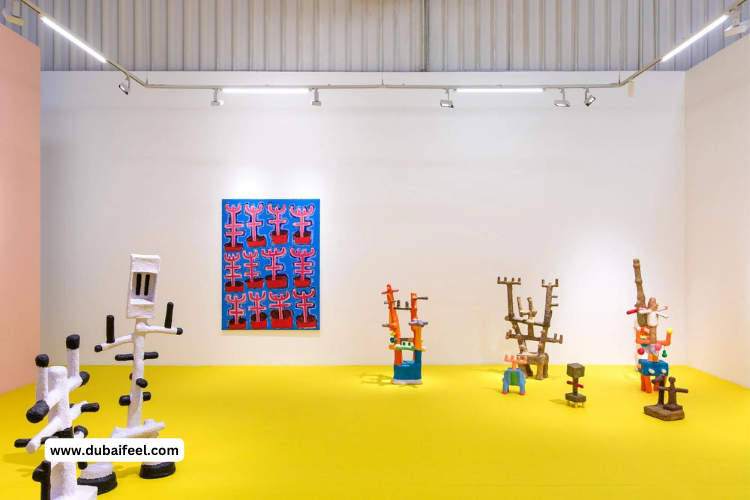
Let’s explore artistic discourse at Lawrie Shabibi, a hub of contemporary expression nestled within Dubai’s vibrant Alserkal Avenue; Lawrie Shabibi Gallery stands as a beacon of modern artistic expression in the heart of the Middle East. Founded by William Lawrie and Asmaa Al-Shabibi in 2011, the gallery has become renowned for its devotion to displaying innovative and thought-provoking works by appearing artists from the region and beyond.
Lawrie Shabibi has a vision to foster dialogue, critical inquiry, and cultural exchange through contemporary art. The gallery seeks to challenge conventions and push boundaries, presenting works that engage with pressing social, political, and cultural issues while celebrating the diversity and creativity of the artists it represents. At the core of Lawrie Shabibi’s success is its dedication to curatorial excellence.
The gallery’s carefully curated exhibitions feature diverse mediums, styles, and perspectives, offering visitors a multifaceted experience that reflects the complexity of the contemporary art world. Each exhibition, from painting and sculpture to video art, photography, and installation, is held to provoke thought and spark conversation.

Lawrie Shabibi focuses on artists from the Middle East, North Africa, and South Asia, providing a global platform for amplifying their voices. Through its exhibitions and programs, the gallery aims to challenge stereotypes and misconceptions about the region, portraying the depth and diversity of artistic talent beyond Western-centric narratives.
In addition to its exhibition program, Lawrie Shabibi is committed to engaging with the local community and nurturing the next generation of artists and art enthusiasts. The gallery hosts artist talks, panel discussions, and educational workshops, providing opportunities for dialogue and exchange between artists, curators, scholars, and the public. Through these initiatives, Lawrie Shabibi seeks to demystify contemporary art and make it more accessible and relevant to a broader audience.
Lawrie Shabibi’s commitment to artistic excellence has earned it international recognition and acclaim. Regularly engaging in major art fairs and exhibitions across the globe, the gallery introduces its artists’ work to fresh audiences and establishes international connections with galleries, collectors, and institutions. This global presence elevates the profile of the artists Lawrie Shabibi represents and contributes to the broader discourse surrounding contemporary art from the Middle East and beyond.
Lawrie Shabibi Gallery is a dynamic hub of contemporary artistic expression, pushing boundaries, challenging perceptions, and fostering dialogue across cultures and borders. Through its commitment to curatorial excellence, regional focus, and engagement with the local and international community, the gallery plays a vital role in shaping the contemporary art landscape in the Middle East and beyond. Whether you’re a seasoned art enthusiast or simply curious about modern art, visiting Lawrie Shabibi promises an enriching and inspiring experience that transcends boundaries and expands horizons
Alsoo read :Dubai luxury car rentals: Drive in style around the city
